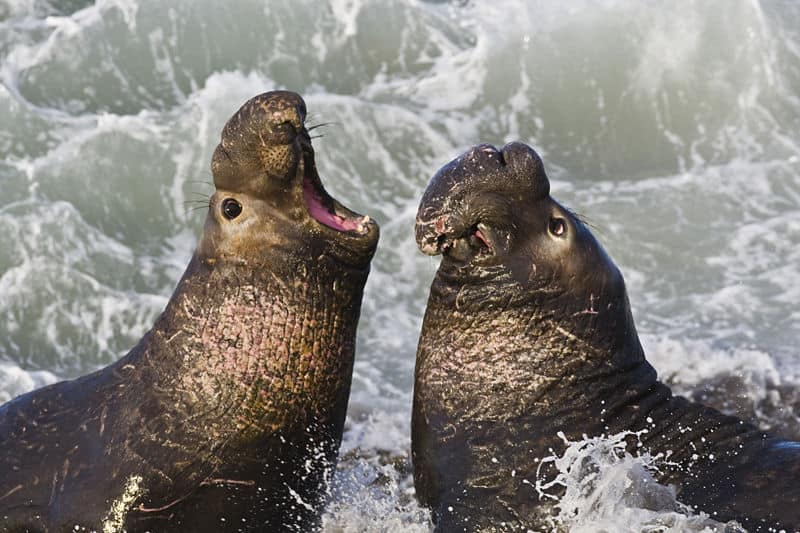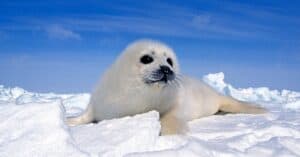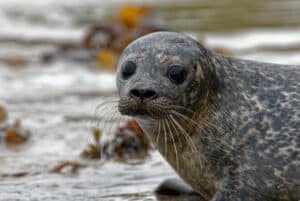What’s a seal? True seals are earless, while fur seals and sea lions both have external ears. From a taxonomic perspective (how scientists group animals) seals belong to a large clade of semi-aquatic animals called Pinnipeds that include seals, sea lions, and fur seals. There are currently 34 extant species of pinnipeds and around 50 extinct species.

When organizing lists, many issues come to mind, including any new or recent taxonomic changes. There is a category of “true” seal, also called Phocidae, which has 18 species and two genera within it. If studying true seals only (which does not include sea lions and walruses), the top ten list of the largest seals in the world would look like this:
10. California Sea Lion: (Up to 2.7 m or 8.9 ft. long) (Up to 770 lbs.) Zalophus californianus
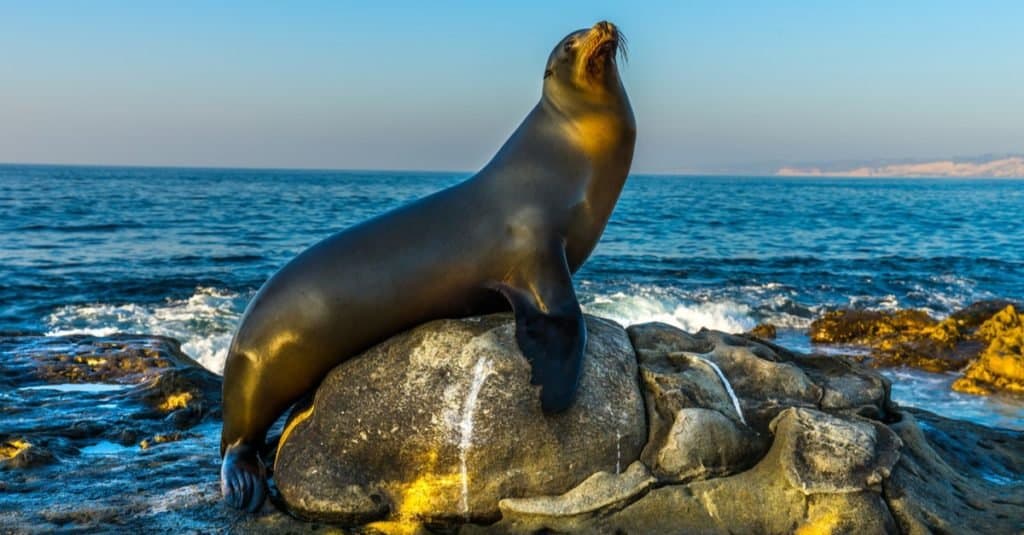
A Californian sea
lion
sitting on a rock in the reefs of La Jolla beach. On land, a sea lion can rotate its hind flippers underneath the pelvic girdle, enabling it to support its weight and walk on all fours.
©Daniel Avram/Shutterstock.com
These intelligent and highly visible animals are found in coastal waters, on beaches, jetties, docks, and buoys. Their natural range extends from Alaska all the way down to Mexico. Unlike true seals, the six species of sea lion have small visible ear flaps and can turn their hindlegs forward for more maneuverability when they’re walking on land.
California sea lions express polygynous breeding tendencies, meaning males set up territories and try to attract females. Females are free to move between territories and choose a mate as they see fit. Males can successfully mate with several females. The sea lions feed on a variety of small fish, squid, and sometimes clams; they are preyed upon by great white sharks and orcas. California sea lions also bark like dogs to communicate. Zalophus californianus is protected throughout its range, and populations have been rising since the 1970s.
9. South American Sea Lion: (Up to 3m or 9.8 ft. long) (Up to 770 lbs.) Otaria flavescens
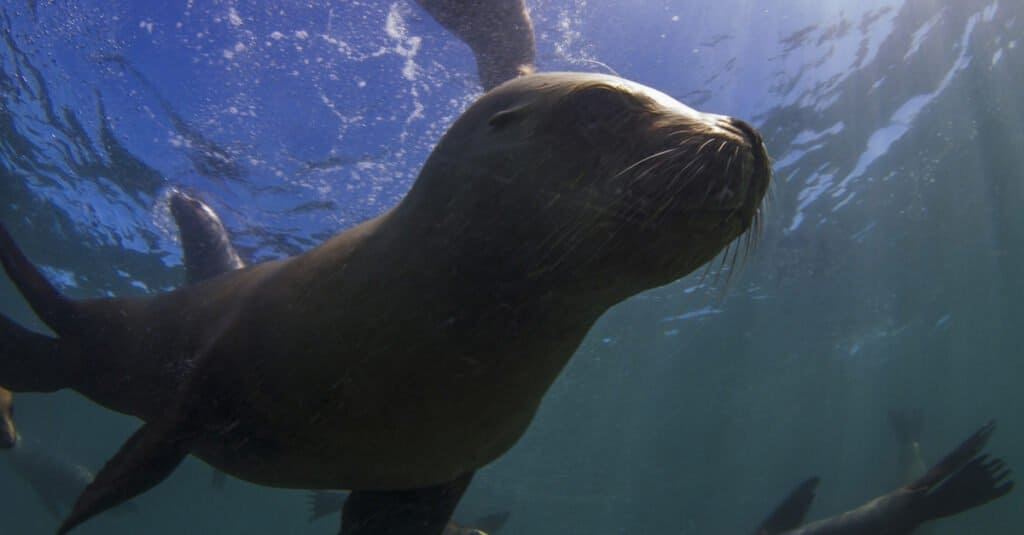
The South American sea lion can reach up to 770 lbs
©Foto 4440/Shutterstock.com
Similar to the California sea lion, the South American sea lion is an intelligent, social marine animal that barks to communicate. Like all sea lions, the South American uses its powerful fore flippers for propulsion through the water. It is the only member of its genus and is also called the southern sea lion or Patagonian sea lion.
Like the California sea lions, female South American sea lions are a blonde or yellow coloration while males are dark brown to black. This species also has a similarly large habitat range, extending south along the Pacific Ocean from Ecuador to Cape Horn and then back up the Atlantic side to southern Brazil. Hunted at one time by both European colonists and Native Americans, the population is now considered stable, with estimates at more than a quarter-million members.
8. Bearded Seal: (Up to 2.7 m or 8.8 ft. long) (Up to 948 lbs.) Erignathus barbatus

The bearded seal is the largest arctic seal
©Sergey Uryadnikov/Shutterstock.com
The first true seal on our list (see our full guide on the differences that separate seals vs. sea lions), the bearded seal is the largest of all the arctic seals. While it is shorter than the sea lions listed above, its maximum weight dwarfs the other entries by hundreds of pounds, hence its numeric rating. The name comes from the large whiskers (used for finding food) common on this species. Closely associated with arctic terrain and sea ice, the bearded seal’s movements and migrations match the extent and retreat of sea ice. This means they are on the front lines of climate change as the composition of the arctic rapidly shifts. Currently, however, there are an estimated half-million bearded seals on earth, putting them in the least concern category according to the IUCN.
Unlike the sea lions above, the female bearded seals are generally larger than the males. They feed on a combination of fish, squid, and clams. Their main predators are polar bears and orcas. The Inuit people of Northern Canada also dine regularly on the seal. Baby seals are called pups, and they are usually born on floating pieces of ice before taking their first dive into the water only hours into their lives.
Bearded seals are also unique for their vocalization. Underwater, it sounds like a haunting song with oscillating higher pitches, usually ending in a moan. The oscillating higher pitches are known as a trill, and the frequency of the songs lessens as the mating season approaches.
7. New Zealand Sea Lion (Up to 3.5 m or 11.5 ft. long) (Up to 990 lbs.) Phocarctos hookeri
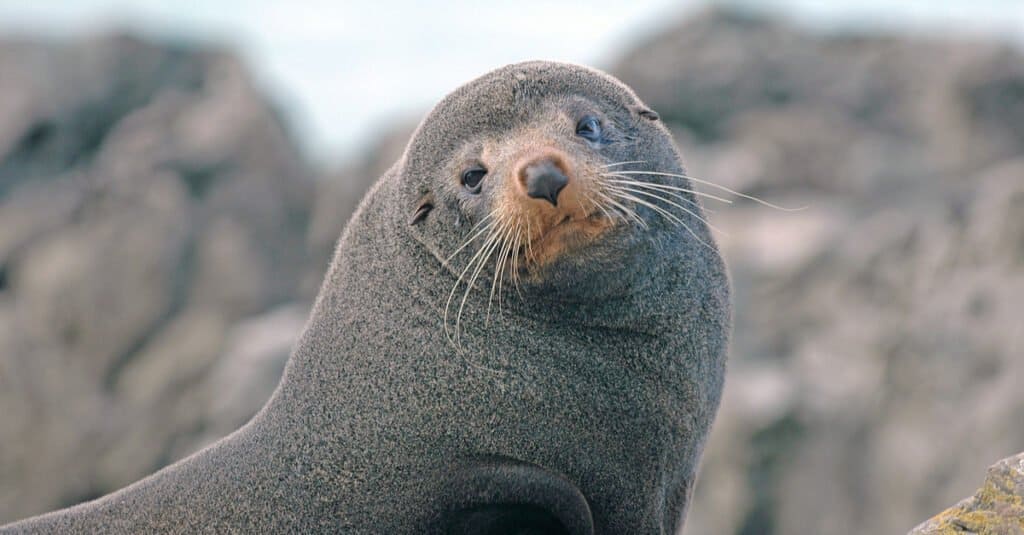
New Zealand sea lions can weigh nearly 1,000 pounds!
©nyker/Shutterstock.com
One of the rarest sea lions on earth, this species is only found in New Zealand, and its total population falls somewhere around 12,000 members. Other common names include Hookers sea lion and whakahao in Maori (the Maori are the dominant native population in New Zealand). The sea lions have a blunt nose, short whiskers and are sexually dimorphic (one sex is larger than the other). The IUCN lists them as endangered due to their relatively small numbers and threats from commercial fishing, hunting, and habitat loss.
New Zealand sea lions are non-migratory, which puts pressure on the conservation of their established breeding grounds to guarantee the continuation of their species. They are also proficient divers, able to dive 600 meters below the surface to search for food. Their diet remains consistent with other entries, consisting of fish, squid, and clams. The only know predator of this specific sea lion is the great white shark.
6. Leopard Seal (Up to 3.5 m or 11.5 ft. long) (Up to 1320 lbs.) Hydrurga leptonyx
The first entry on our list with a weight range extending over one thousand pounds, the Leopard seal is a big animal. It is one of the largest seals in the Antarctic, comparable to the Weddell seal listed below and behind the southern elephant seal. Being a true seal, they don’t have a visible ear but do have an inner ear canal that leads to a small external opening. With a stable overall population, the IUCN lists them as least concern.
The leopard seal is named after the spotted pattern on their skin, which is darker on top and lighter at the bottom. Unique among true seals, the Leopard has massive jaws, sharp incisors, and a long, almost reptilian-like skull. Due to these adaptions, it is a top predator in its environment and only experiences consistent predation from the even larger orca whale. The leopard seal dines on a large variety of foods including squid, krill, fish, and even some birds.
5. Weddell Seal (Up to 3.5 m or 11.5 ft. long) (Up to 1320 lbs.) Leptonychotes weddellii
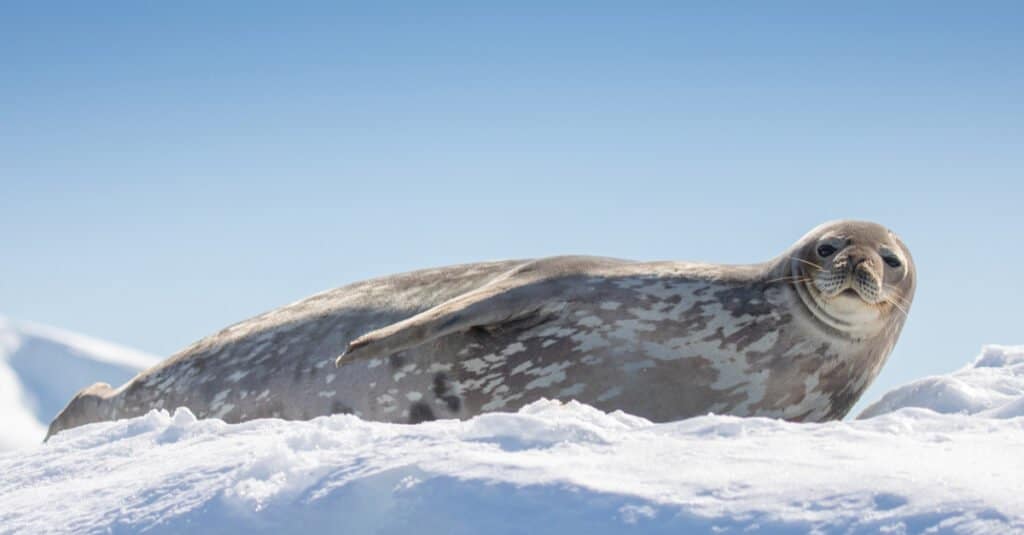
Weddell seals are very similar in size to Leopard seals
©Michelle Sole/Shutterstock.com
Similar in size to the Leopard seal, this true seal is the most southern-ranging mammal on Antarctica. They are usually a dappled grey color with black on their backs and a mostly-white underbelly. Weddell seals have been noted for their relatively small heads when compared to the rest of their body.
Weddell seals live primarily on fast ice or ice that is connected to the land. They aren’t migratory, being limited to the circumpolar regions, and feed on what could be considered standard food for seals (shrimp, squid, and crustaceans). Weddell seals have also been observed often lying on their sides when they are on land. With an estimated population in excess of 200,000, they are listed as least concern by the IUCN, though that may change depending on the long-term effects of climate change on sea ice extent.
4. Steller Sea Lion (Up to 3.25 m or 10.6 ft. long) (Up to 2470 lbs.) Eumetopias jubatus
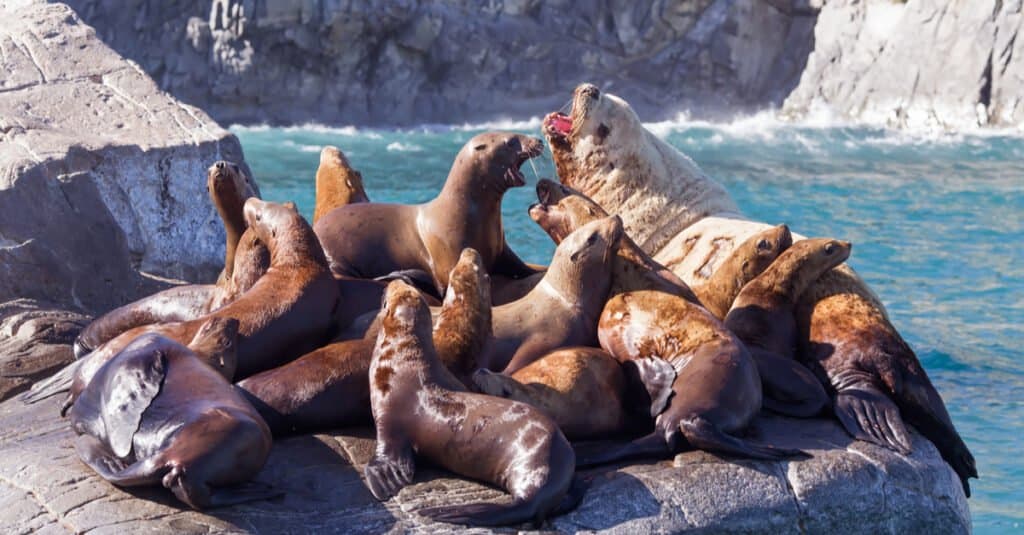
A group of Steller sea lions on a rock
©Alexander Machulskiy/Shutterstock.com
The Steller Sea Lion is the largest species of sea lion in the world. It shares some of its habitat with the California sea lion, but instead of barking, lets out an impressive low-frequency roar. Widespread and unexplained population declines caused it to become listed under the Endangered Species Act in 1990. There are two distinct population segments; one (the eastern) has made a remarkable recovery and is no longer listed. The western population segment is still listed as endangered.
The Steller is lighter in color than other sea lions, oscillating from a pale yellow to reddish. They have a large range, from Japan and pacific Siberia northeast across the Pacific Ocean (into the arctic circle) and along the coasts of Alaska, Canada, Washington, Oregon, and parts of California. The Stellar is an opportunistic feeder and focuses its effort on the most abundant local prey. Some well-known food favorites include mackerel, salmon, halibut, Pacific cod, herring, squid, and octopus. Being such a top-tier predator, both in terms of its size and hunting opportunism, the Steller really only experiences predation from orca whales and occasionally sharks.
3. Walrus (Up to 3.6 m or 11.8 ft. long) (Up to 4000 lbs.) Odobenus rosmarus
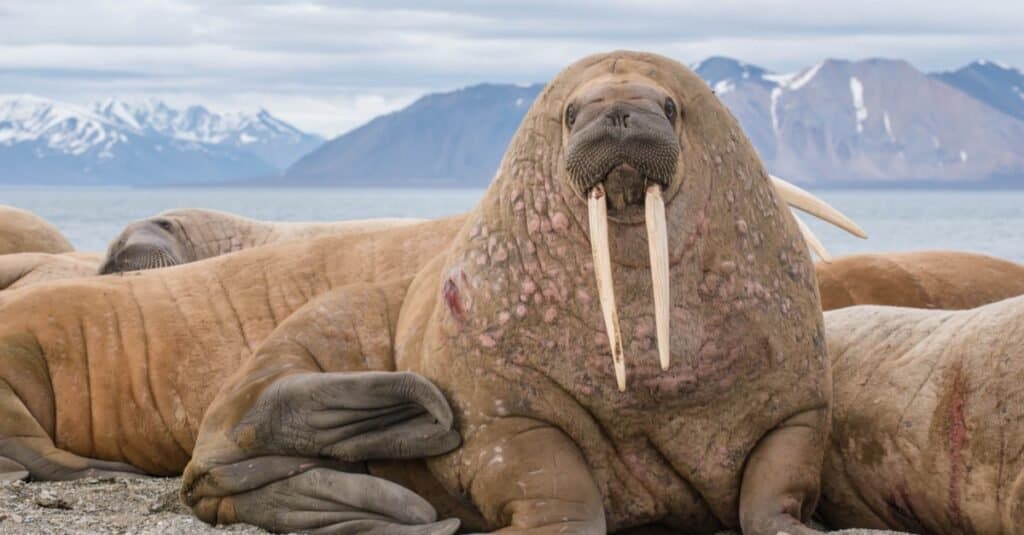
The walrus is a marine mammal, the only modern species of the walrus family, traditionally attributed to the pinniped group. One of the largest representatives of pinnipeds.
©Mikhail Cheremkin/Shutterstock.com
The walrus is a unique, large flippered marine animal. It is the only species in its genus and family, which makes it difficult to leave it out of any list involving similar species like sea lions and seals. Unlike them, however, walruses have tusks, which are enormous canine teeth that stick out of their mouth. Tusks can reach a length of over three feet and weigh as much as 12 pounds. Like other similar species, Walruses also have visible whiskers.
Walruses prefer shallow waters and spend a lot of time on sea ice, where they look for their favorite food, bivalve mollusks (aka clams). Despite their preference for clams, Walruses have been known to eat up to sixty different genera of marine organisms. Similar to other cold-weather seals, the Walrus experience predation from orcas and polar bears, but not much else can take on its robust size. A healthy Walrus can live up to 30 years in the wild.
2. Northern Elephant Seal (Up to 5 m or 16.5 ft. long) (Up to 5100 lbs.) Mirounga angustirostris
At number two on our list, the northern elephant seal is the largest true seal in the northern hemisphere. The most identifiable part of elephant seals (both the northern and southern variety) is the presence of a large, inflatable nose on the males. The nose overhangs their lower lips and is used for males to transit warnings to other males. The roar that elephant seals emit through their nose is deafening. Their range is in the eastern Pacific Ocean, and they are commonly seen on beaches from California to Mexico.
Pups are born black and eventually turn brown or grey as they mature. While their diet matches fairly well to previous entries in the list, they have also been known to dine on rays and some varieties of shark. Adults spend up to nine months of the year in the ocean, where they dive for long periods of time to search for food. They return to land to breed and molt, which can take up to five weeks. Males are very territorial and aggressive during breeding. The dominant males can establish harems of females; the smaller males will attempt to mount females belonging to a harem. They are occasionally successful, but the dominant male (bull) will often fight the encroaching male resulting in blood and injury, but not usually death.
1. Southern Elephant Seal (Up to 5.8 m or 19 ft. long) (Up to 8800 lbs.) Mirounga leonina
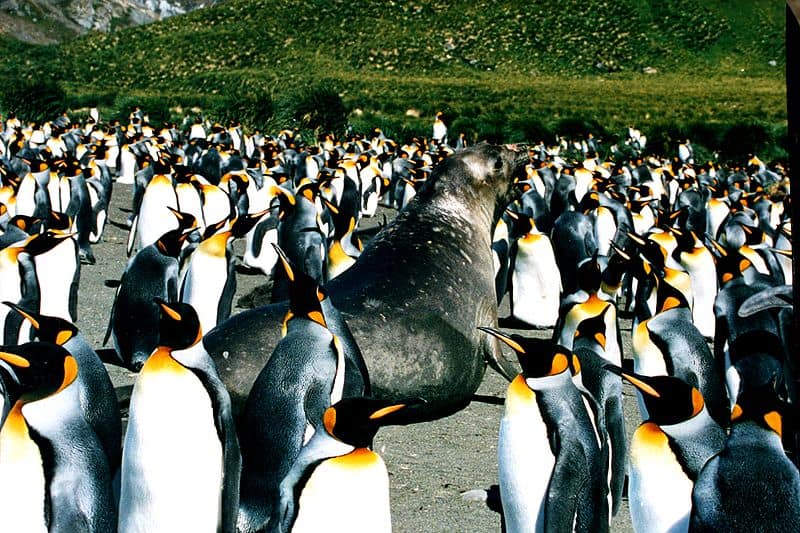
King Penguins and Southern Elephant Seal at South Georgia Island
The southern elephant seal is the largest seal alive on earth today. It can get almost three feet longer than the northern elephant seal and can weigh over 3000 pounds more. Like its sister species, the southern elephant seal’s is identifiable by the large and drooping nose present on the males. Between the two, the southern elephant seals nose is slightly smaller than the northern elephant seal. The range of the southern elephant seal is significant and extends around Antarctica, making it susceptible to rapid climate shifts.
Like many other seal species, the southern elephant seal is sexually dimorphic, with the males being four to five times larger than the females. They are also capable of staying on land for weeks at a time, and like the northern elephant seal, engage in bloody combat between bull males during mating. Their diet is typical for seals, but the southern elephant can dive deeper than many of its peers, up to 3,000 feet under the surface, and stay underwater for more than twenty minutes. Because of their massive size, there isn’t much that hunts the southern elephant seal, although weakened juveniles may be eaten by orcas, sharks, and occasionally other seals like the New Zealand and Leopard seals.
Summary Of The 10 Largest Seals In The World
| Rank | Seal | Size in Length & Weight |
|---|---|---|
| 10 | Harbor Seal | Up to 1.85 m or 6.1 ft. long and up to 370 lbs |
| 9 | Hawaiian Monk Seal | Up to 2.1 m or 6.8 ft. long and up to 400 lbs |
| 8 | Crabeater Seal | Up to 2.3 m or 7.5 ft. long and up to 440 lbs |
| 7 | Hooded Seal | Up to 2.6 m or 8.5 ft. long and up to 661 lbs |
| 6 | Grey Seal | Up to 2.3 m or 7.5 ft. and up to 680 lbs |
| 5 | Bearded Seal | Up to 2.7 m or 8.8 ft. long and up to 948 lbs |
| 4 | Leopard Seal | Up to 3.5 m or 11.5 ft. long and up to 1320 lbs |
| 3 | Weddell Seal | Up to 3.5 m or 11.5 ft. long and up to 1320 lbs |
| 2 | Northern Elephant Seal | Up to 5 m or 16.5 ft. long and up to 5100 lbs |
| 1 | Southern Elephant Seal | Up to 5.8 m or 19 ft. long and up to 8800 lbs |
The photo featured at the top of this post is © FiledIMAGE/Shutterstock.com
Thank you for reading! Have some feedback for us? Contact the AZ Animals editorial team.




